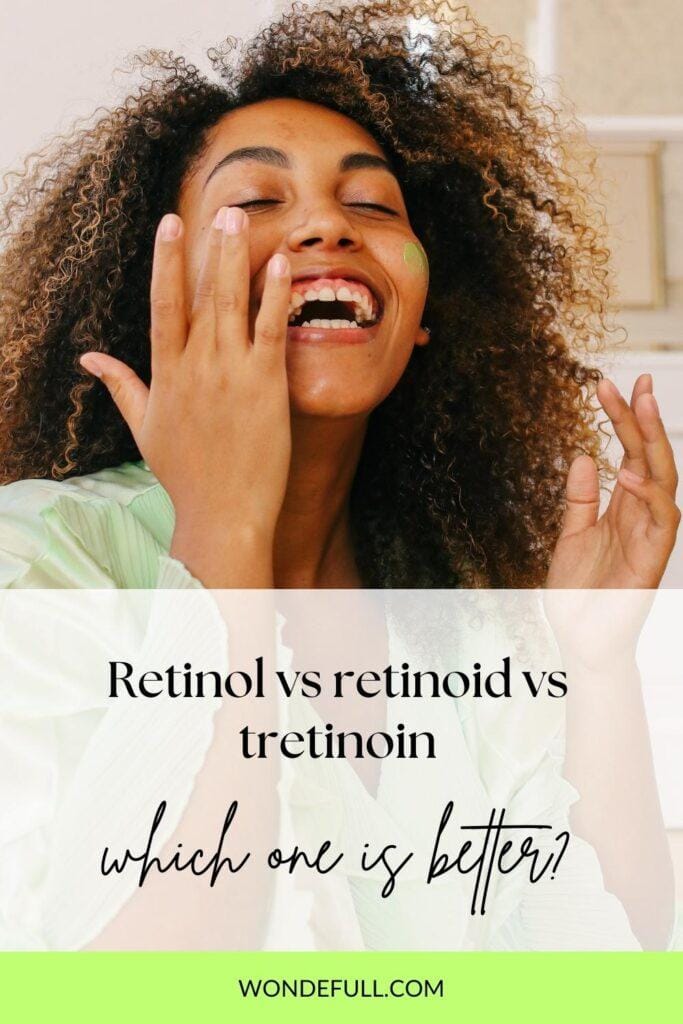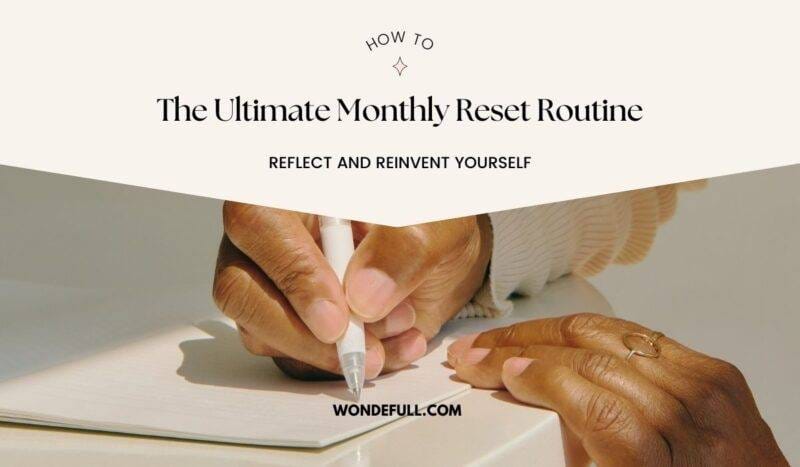You must have heard of Retinol, Retinoid, and Tretinoin – the proven skin renewal ingredients recommended by dermatologists. Although they all belong to the retinoid family, they vary in terms of strength, efficacy, and usage. Additionally, there are retinal and granactive retinoids to consider. If you’re uncertain about your next steps, don’t fret. By continuing to read, you’ll unravel the nuances of retinol vs retinoid vs tretinoin, to help you decide which one to include in your skincare routine.
I will also guide you on how to incorporate these retinoids into your skincare routine while minimizing the effects of the notorious purging.
Retinol vs retinoid vs tretinoin and how does it affect our skin?
Retinoid is the big brother of all; it represents a group of vitamin A derivatives. No matter which retinoids you choose, they all need to be converted to retinoic acid to work. Below is how the retinoids convert to retinoic acid.

| Retinol Esters | Retinol | Retinal | Retinoic Acid Esters | Retinoic Acid / Tretinoin / Adapalene | |
| Availability | Over the counter | Over the counter | Over the counter | Over the counter | Prescription only in certain countries |
| Main benefits | Treat skin aging | Treat skin aging | Treat skin aging | Treat skin aging | Treat acne and skin aging |
| Time taken for the effect | 3-6 months | 2-4 months | 2-3 months | 1 ½ -3 months | 1 -2 months |
| Irritation level | 1 | 2 | 3 | 2 | 5 |
Essentially, retinoic acid is an active ingredient that does its job in speeding up skin cell turnover which makes way for new cell growth. This explains why all retinoids carry anti-aging effects and the ability to address various skin concerns such as uneven skin tone and texture resulting in glowing and youthful skin. They mainly help:
- Reduce fine lines and wrinkles
- Lighten hyperpigmentation due to acne/scar
- Improve skin texture
- Brighten skin, giving a more radiant look
What are the side effects?
Despite being widely used for many years, like most skincare products, they share similar potential side effects. Tretinoin has been known to have a greater risk of side effects than retinol – due to its strength. These side effects are manageable and won’t happen to everyone but you must be aware of the risks before you start using either product. Familiarise yourself with the list of potential risks and how to prevent them below:
- Photosensitivity: To avoid the skin reactions such as redness, rash, itching, or blisters when skin is exposed to sunlight or an artificial UV light source, you will need to use sunscreen daily
- Skin Irritation: Start with a pea-sized of retinol and only apply it to your face once every week to prevent the skin from getting irritated
- Pregnancy and nursing risks: If you want to use tretinoin or retinol you must not be pregnant or breastfeeding.
Types of retinoids and products
Now let us dive deeper into each retinoid and the recommended products including what I had used.
If you want to buy the product listed, you are most welcome to use my link. If it’s not for you, no pressure, no need to buy!
Retinol Esters – the mildest
Starting with the mildest types of retinoids — retinol esters, they need to be converted three times within our skin before they become active. This makes them a good choice for sensitive, reactive skin and anyone new to retinoids, as they are unlikely to cause any irritation.
However not all retinol esters are made equal, and there’s research shown that retinyl propionate is the most promising retinol ester to reduce wrinkles and pigmentation.
Retinol ester products to try:

Paula’s Choice Triple Active Total Repair Serum 30ml ($48): This advanced anti-aging serum is clinically proven to visibly improve lines, discoloration & firmness with a potent blend of 0.4% hexylresorcinol, 0.3% retinyl propionate, and 5% niacinamide. It is a light, hydrating serum for all skin types

Murad Retinol Youth Renewal Night Cream 50ml ($70): is a retinol and retinyl propionate cream that claims that 93% of its users saw a reduction in lines and wrinkles in 2 weeks.
Retinol – the most popular
Retinol is a synthetic form of vitamin A and does not affect the skin directly. Enzymes in the skin would need to convert twice into retinoic acid first. Due to these factors, it may take 3–6 months to notice differences in the way our skin looks and feels.
There’re tons of retinol serums in the market, so you will be able to find one that suits you. At the beginning of your retinol journey, it can be quite irritating to the skin and causes dry/flaking skin if the formulation is too strong. While it is common, it is always recommended to start with a pea-sized amount of a lower concentration (0.5%) and use it twice a week, slowly increasing the usage to give the skin a chance to acclimate.
Retinol products to try:

The INKEY List Retinol Fine Lines and Wrinkles Serum 30ml ($13): This is an affordable serum that contains 1% retinol and 0.5% granactive retinoid.

Drunk Elephant A-Passioni Retinol Cream 30ml ($99): An oil-based cream that has 1% retinol combined with Vitamin F, aiming to improve your skin’s texture while helping to calm signs of sensitivity. I had seen a sale on this that dropped to $60.

The Ordinary Retinol 1% in Squalane 30ml ($15). This oil-based serum boasts the highest possible (1%) retinol concentration in The Ordinary retinol collection. It is available in 0.5% (my first retinol product 👍), and 0.2% concentration.
Retinal – typo of retinol?
Retinal is not to be confused with retinol. It is short for Retinaldehyde, which is the direct precursor of retinoic acid — meaning it is directly converted into active vitamin A by our skin. As such, retinaldehyde can produce skin changes that are comparable to retinoic acid.

Naturium Retinaldehyde Cream Serum 0.05% ($29): Naturium has a few retinoid products and this retinal serum is formulated for those who have dry and sensitive skin.

Avène RetrinAL 0.1 Intensive Cream 30ml ($79): A 0.1% retinaldehyde cream that promises to reduce the appearance of deep wrinkles and furrows while smoothing and renewing skin, without irritation.

Allies of Skin Retinal and Peptides Repair Night Cream 50ml ($32): This cream has the brand’s patented Ally-R™ (an encapsulated form of time-release Retinaldehyde) to blur the tell-tale signs of aging while promoting a firmer, more balanced complexion. Meanwhile, a 13.5% Peptide Complex reinforces the skin’s moisture barrier for resilient, healthy-looking results.
Retinoic Acid Esters – the newest addition
Retinoic acid esters are a new generation of retinoids that are popping up in more and more products. Although we don’t have a lot of data on them yet, they show promise for being more active than retinol, without the irritation while having similar benefits or treating wrinkles, and work on mild to moderate acne by fighting bacteria and reducing sebum production.
One type of retinoic acid ester is retinyl retinoate. It breaks down into both retinoic acid and retinol, making it active within one step (just like retinaldehyde), as well as more active later on, once the retinol is converted.
The other type of retinoic acid ester is hydroxypinacolone retinoate (HPR), which you might be familiar with as “granactive retinoid” (a term popularized by The Ordinary). Granactive retinoid is simply a complex that includes HPR, the active, in a 1:10 ratio with a solvent, dimethyl isosorbide. So when you see a percentage of granactive retinoid being quoted, be aware that you need to divide by 10 to get the actual concentration of HPR.
Granactive retinoids are believed to work directly on retinoic acid receptors in the skin cells, potentially making them more efficient in delivering retinoid-like benefits with less irritation. While granactive retinoids still need some conversion in the skin to fully exert their effects, they are designed to be more bioavailable and require fewer conversion steps compared to traditional retinol. This can result in potentially faster and more visible results, along with a reduced likelihood of irritation. Hence, not only is it less irritating than Tretinoin, but it is also less irritating than even 0.5% retinol.
Retinoic acid ester products to try:

The Inkey List Retinol Serum 30ml ($13): This is a serum that contains 1% retinol and 0.5% granactive retinoid

The Ordinary Granactive Retinoid 2% in Squalane 30ml ($15): It is a non-irritating, oil-based retinoid with 0.2% HPR. It is also available in 5% concentration.

The Ordinary Granactive Retinoid 2% Emulsion 30 ml ($15): It is a creamy serum with 0.2% HPR plus an encapsulated retinol.
Retinoic Acid – the strongest
Retinoic acid is a synthetic form of vitamin A. It doesn’t need to be broken down by enzymes in our skin for it to work. In the battle of retinol vs retinoid vs tretinoin, retinoid acid works the fastest, and results can be seen in 6–8 weeks depending on the individual. But its effects can be much harsher, which is why most countries require it to be prescribed by a dermatologist. Here are a few types of retinoic acid:
- Tretinoin: Most commonly known retinoic acid that is used to treat acne, even out skin pigmentation, and as a non-invasive treatment for fine lines and wrinkles.
- Adapalene: It’s available both over-the-counter and in prescription form, but the OTC is only in 0.1% concentration
- Isotretinoin/Accutane: The oral form of retinoic acid and the most potent of all retinoids — thus, it’s often reserved for more severe and resistant forms of acne.
How to add retinol to your skincare regime
If you’re new to this side of the skincare world and are keen on incorporating retinoids into your skincare regime, but too scared to because of its side effects — don’t worry! I have got you covered with the following steps:
- Start with retinol of a lower concentration of 0.2%. You can opt for a higher concentration if you don’t have dry and sensitive skin.
- You can start by applying products of lower viscosity to higher viscosity: Face wash > Toner > Serum (retinol) > Moisturizer > Face Oil > Sunscreen
- You need to gradually incorporate it into your routine, from once a week to two or three times a week.
- While your skin is acclimatizing to retinol, pay close attention to your skin. If there’s dryness or purging, take it slow and you may mix your retinol with your moisturizer at 1:1. It is all about balance, and do not rush it. Another way is sandwiching retinol between moisturizing cream, lotion, or gel, depending on your skin type.
- Once you start to get clearer skin, you can switch it up to a higher concentration of retinoid product eventually.
Can you use retinol and tretinoin together?
Since both products are derived from Vitamin A providing similar effects, there is no need to use them both. Using both together is discouraged due to their skin-irritating tendency.
Ideally, you should start with retinol, as it is the milder of the two, and consider transitioning to tretinoin if you are not achieving your desired results. For skincare beginners who have not used many active ingredients, retinol would be the safer and more suitable choice.
What to avoid when using retinoids?
There are a few skincare ingredients that you’ll want to skip when applying retinoids. Don’t use retinoids with vitamin C, benzoyl peroxide, and AHA/BHA acids at the same time.
AHA and BHA acids are exfoliating, which can further aggravate your skin when used with retinoids.
As for benzoyl peroxide, it is great for battling acne but it is drying to the skin. If combined with retinol, it is just a catalyst for flaking disaster.
Finally, vitamin C is a great skin ingredient that shields the skin from environmental aggressors. To prevent irritation, vitamin C and retinol are best used at opposite times of the day – vitamin C in the AM and retinol in the PM.
The Ordinary retinol vs granactive retinoid vs tretinoin
I have experience using different retinoids on my combination skin, and here’s my retinol vs retinoid vs tretinoin verdict.
I started with The Ordinary Retinol 0.5% in Squalane and my skin had gotten better without any purging. It took me 3 months to see significant improvements as I used it once a week in the beginning. Then I switched to Retacnyl Tretinoin Cream 0.05% which was too strong for my skin, causing redness and irritation.
So I stopped for a few months until I came across The Ordinary Granactive Retinoid 2% Emulsion which is of a lighter formula with less concentration. So far, I’m happy with using it once a week as I’m using other AHA/BHA exfoliants.
Other than looking at the concentration and potency of retinoid products, I recommend you look at the viscosity and other ingredients paired with retinoids. For me, squalane oil is too heavy for my combination skin. Despite the smoother skin texture, my face got very oily after applying it in a tropical country.
Retinol vs retinoid vs tretinoin – which should you choose?
You’re hyped now after seeing many successful cases where retinol has helped slow down skin aging and smoothened skin texture, including mine. However, you still have to consider the factors, such as your skin type, skin concerns, hormonal balance, and allergy.
You can also seek advice from a dermatologist to help you pick the most suitable retinoid product and even obtain a prescription. At the end of the day, you have to understand your skin well, in order to do what’s best for it.
If you decide to include retinoids in your skin regime, remember to start with a less potent retinoid at a lower concentration. And you must remember to apply sunscreen even if you are sitting in the room! For those who are embarking on this journey, may all of us enjoy smoother and more radiant skin from using retinoids~
What retinoid product are you interested in trying? Feel free to comment below!
Like this post? Share it on Pinterest – thank you!


Disclaimer: Some links contain affiliate links. Should you decide to purchase through these links, a small commission is earned, without any added cost to you. This support is what fuels our blog, allowing us to continue sharing genuine content that we hope enriches your life.



